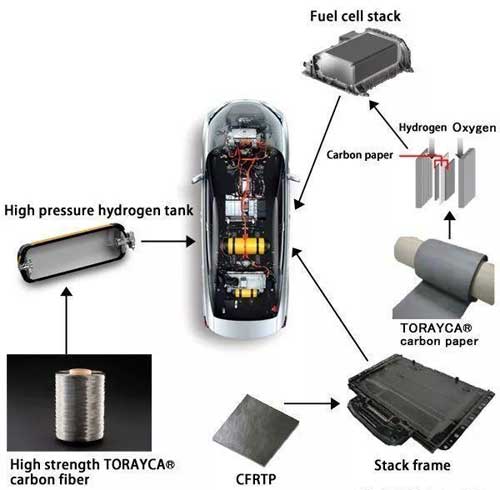In the performance circle, there is such a saying: "More than 10 horsepower is less than 10 kilograms." Strong power does not mean everything. The lightweight body is also the ultimate pursuit of performance cars. Carbon fiber composites (CFRP) are highly regarded for their high strength and stable chemical properties. High-performance models do not have the carbon fiber embellishment.
This article refers to the address: http://

Carbon fiber is good, but the cost is too high, hindering its large-scale application, currently only used in racing, high-end sports cars and high-end models. Under increasingly stringent fuel efficiency and carbon dioxide emissions regulations, lightweighting of the body has become an important means of reducing fuel consumption and reducing emissions. According to research, the vehicle weight is reduced by 10%, and the fuel efficiency can be increased by 6-8%, that is, the vehicle weight is reduced by 100 kg, and the hundred kilometers is reduced by 0.3-0.6L.
The huge potential of carbon fiber in automotive lightweight applications has made it a material option for automotive companies to meet the challenges of fuel consumption. Then, with the constant changes in demand and the increasingly stringent environmental regulations, the application of carbon fiber composites will cause the next wave of innovation in the automotive materials market.
Carbon fiber opportunity window
At present, there are two main ways to reduce the weight of automobiles. One is to optimize the structural design, optimize the structure and skeleton of the vehicle body to achieve the purpose of weight reduction, and the second is to replace the traditional materials with lightweight high-strength materials. Since the birth of the first fiber-reinforced composite car in the world in 1953, GM Corvette, composite materials have officially entered the historical arena in the automotive industry.
In 1979, Ford first published a lightweight test vehicle made of CFRP, which mainly applied carbon fiber composite materials to functional parts such as body panels, drive shafts and leaf springs, while also trying to make the engine body, connecting rods and Zero applications such as pistons. The test vehicle used a total of 300Kg carbon fiber composite material, and the fuel emissions were effectively reduced by 35%. At the same time, its modulus of elasticity is 4-9 times that of FRP and 3-4 times that of metallic materials.
The McLaren F1, which was born in 1992, was the fastest production car on the surface at the time. The first use of CFRP to make the car body was the secret weapon of the king. Carbon fiber meets the difficulty of material production technology, high price, and more applied to super sports cars and F1 racing cars, but its excellent performance characteristics make it a recognized automotive material that meets the future development trend.
BMW's focus on carbon fiber is very high. As early as 2009, BMW and the German SGL Group jointly established a new company specializing in the production of carbon fiber and carbon fiber fabrics for the automotive industry. Starting with the new BMW 7 Series, BMW's main product structure will use carbon fiber materials, and steel is no longer a measure of vehicle toughness. With the launch of the BMW i8 and i3, the BMW has become the only car manufacturer to master the mass production and manufacturing technology of automotive carbon fiber composites.
This is the first time in the history of mass production models to use CFRP to build a large-scale body, which also proves that the cost of carbon fiber has dropped significantly. In the past, carbon fiber formation required a long epoxy pre-soaking process, which took a lot of time and manpower. By optimizing a high-pressure epoxy resin technology, BMW sprays high-pressure epoxy resin into the carbon fiber inside the mold to quickly penetrate into the fiber under pressure. This technology will reduce the production cost of carbon fiber to the current 10% or lower.
BMW officially brought CFRP into the mainstream materials of automobiles, and other auto manufacturers are also making efforts to CFRP. The carbon fiber reinforced thermoplastic composite material developed by Toyota and Toray has built a fuel cell reactor framework and is used in the Toyota fuel cell vehicle Mirai. This is the first time that carbon fiber reinforced thermoplastic composite materials have been used in automotive structural parts for mass production. Car.

At the 2015 Tokyo Motor Show, Yamaha launched the Sports Ride Concept, a new concept sports car weighing only 750kg. The ultra-light body benefits from the iStream CFRP chassis. iStream is a production system developed by Gordon Murray. It uses a lot of carbon fiber materials and greatly reduces the production cost. It not only contains light but high-strength chassis, but also can be born through different combinations of panels to the basic frame. The body style has become the gospel of the entry sports car enthusiasts. At this year's Tokyo Motor Show, Yamaha will launch a continuation of the Sports Ride Concept.
In addition, Volkswagen, Mercedes-Benz, PSA and other car companies are also developing automotive carbon fiber composite materials for body, wheel, seat, hydrogen bottle, front hatch, chassis structural parts, drive shaft and other components.
Carbon fiber bottleneck
Carbon fiber composites are widely used in the automotive industry for their unique properties. They are also regarded as the future development trend of new automotive materials, but they still face many challenges in the application and promotion stage, and these challenges are related to the cost of each component. "Associated.
Reduce carbon fiber production costs. The high carbon fiber price is the main reason for limiting its advantages in many applications compared to steel and aluminum components. At present, the price of carbon fiber per kilogram on the market is more than 120 yuan, which is more than 10 times that of glass fiber. In addition, the price of epoxy resin matched with carbon fiber is also high.
Increase productivity. Most of the current production processes for carbon fiber composite parts are slow and usually take a long time. Reduce manufacturing costs by increasing automation, simulation, and rapid production tempo. For example, BMW uses a high-pressure RTM process to produce a carbon fiber composite body with a production cycle of about 10 minutes.
Optimize recycling. Carbon fiber has more than 30% waste in the production process, which is much higher than the waste ratio of other industries; and as CFRP is gradually applied in mainstream cars, the recycling problem is imminent. In the past, recycling techniques typically used high temperature recovery techniques or chemicals for grinding or decomposition, but it was difficult to achieve safe handling and carbon fibers could be damaged during the process. So a cost-effective carbon fiber recycling program can reduce costs and enhance sustainability.
Develop specialized maintenance techniques. In the process of using the car, it is inevitable that it will encounter repair problems. For traditional metal materials, maintenance personnel have become familiar with the road, but the repair process of carbon fiber composite materials is still quite different from traditional materials. Only by developing special materials for repair and a set of easy-to-use and easy-to-operate repair technologies can CFRP be widely accepted by high-volume automotive platforms.
The introduction of CAFE has prompted major auto companies to increase R&D investment in the field of automotive lightweight technology, and to promote the development of carbon fiber composite materials. Whether carbon fiber composite materials can become the giants of the future automotive materials field, this will take time to verify, but at present, carbon fiber technology is constantly developing, the cost is gradually reduced, and the production efficiency is also increasing. It seems that this will be a High probability event.
Usb-C Switcher,Usb C Switch Selector,Usb Type C Switcher,Usbc Switcher
Dongguan Tuojun Electronic Technology Co., Ltd , https://www.fibercablessupplier.com